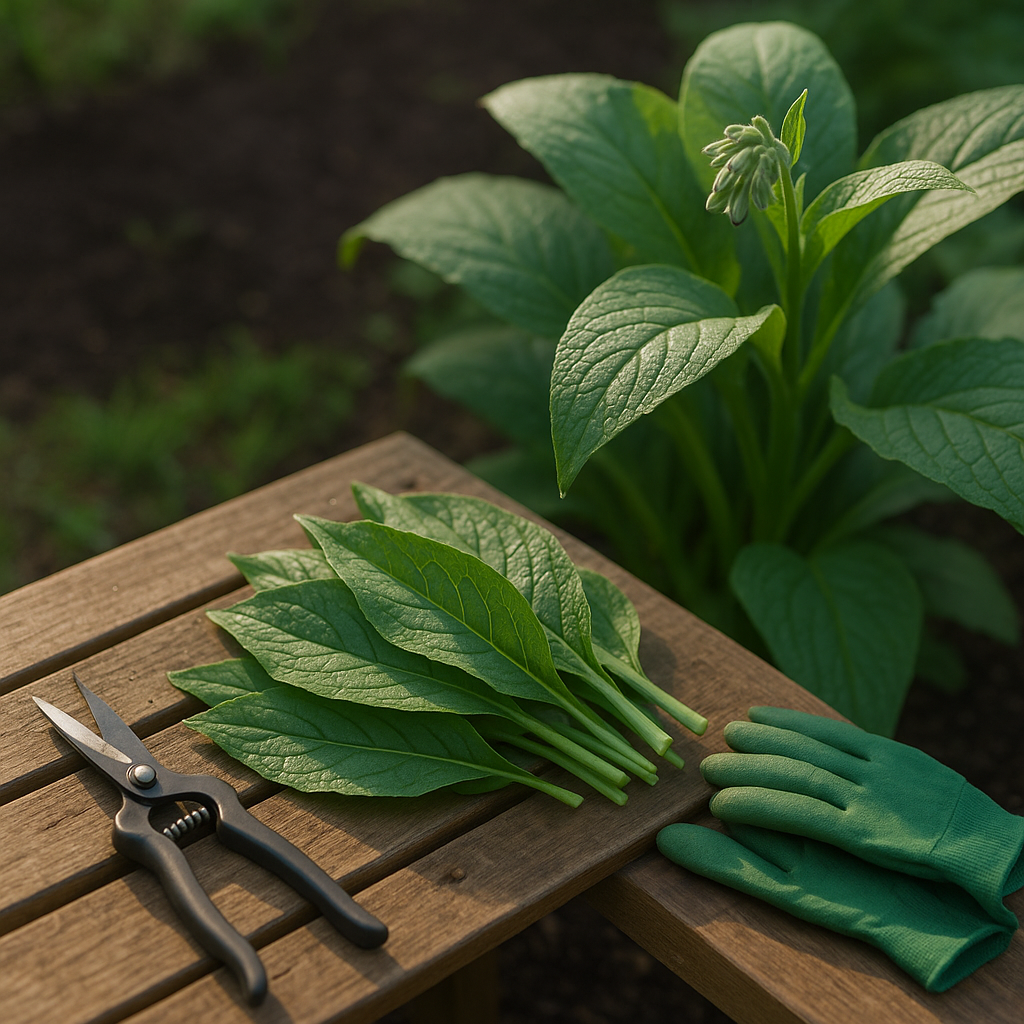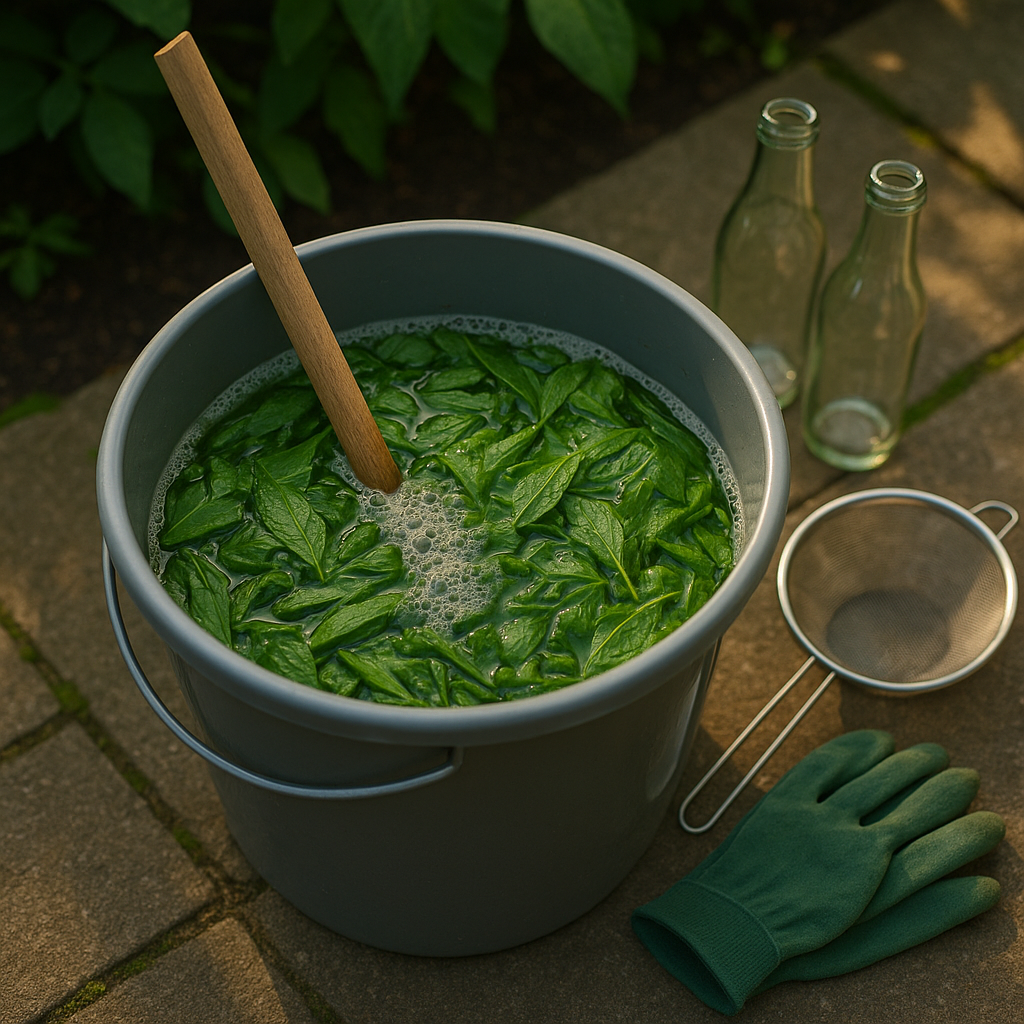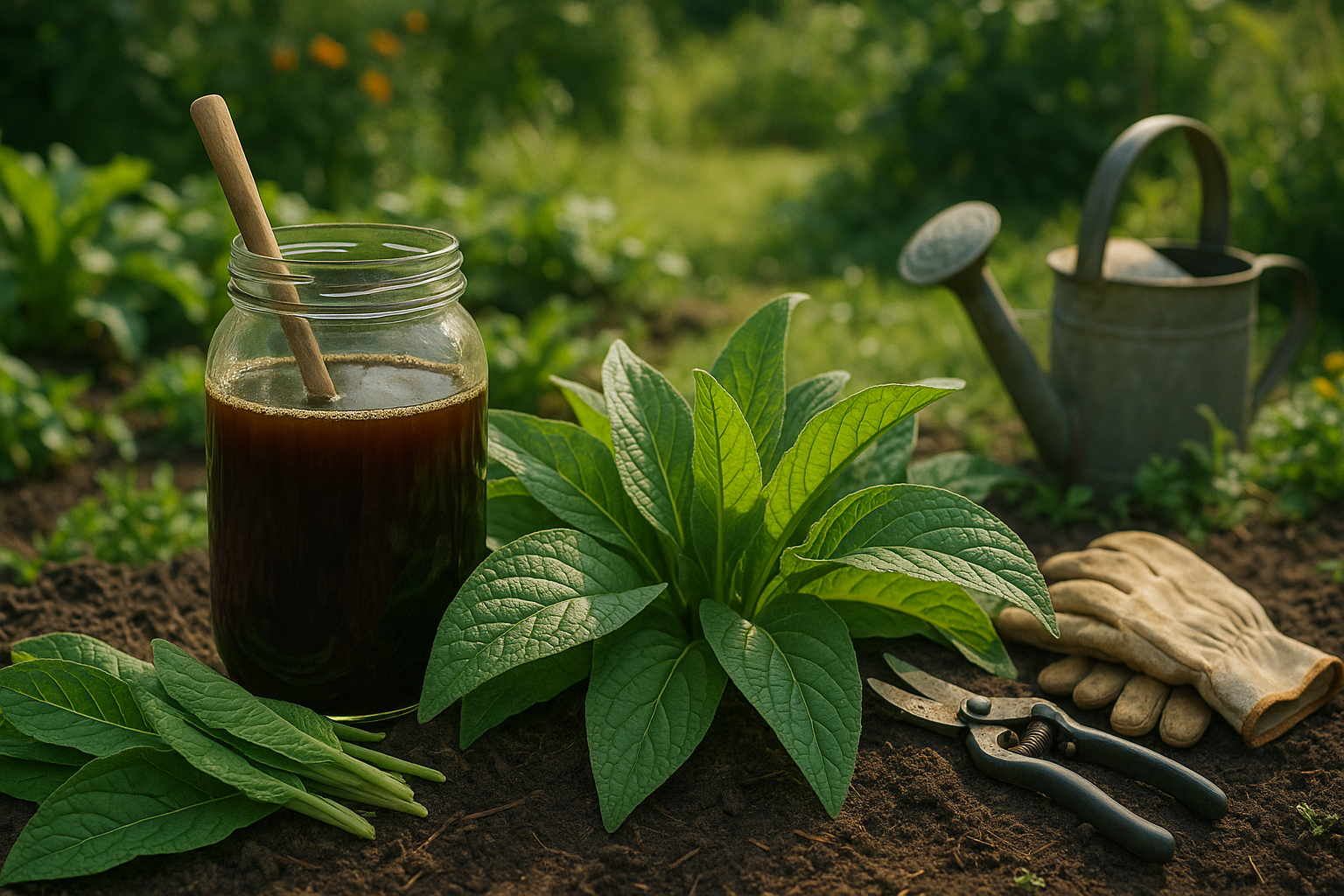How to Make Comfrey Fertilizer or Liquid Tea
Comfrey fertilizer, often called comfrey liquid tea, is a natural garden booster that’s gaining popularity among eco-conscious gardeners. Made by steeping comfrey leaves in water, this nutrient-rich tea delivers essential minerals—like potassium, nitrogen, and phosphorus—directly to your plants, helping them thrive without synthetic chemicals.
Comfrey is especially valued for its ability to replenish tired soils and supercharge fruiting and flowering plants, making it a favorite for tomatoes, peppers, and even roses. Using comfrey tea is not only environmentally friendly but also allows you to recycle garden trimmings into powerful plant food.
Whether you’re tending a vegetable patch or a few potted herbs, this homemade fertilizer can boost yields and improve plant health naturally. Curious to try it yourself? In the steps ahead, you’ll learn how to identify and harvest comfrey at the right time, prepare an effective liquid tea with minimal effort, and use it safely around your garden.
Get ready to see your plants respond with stronger growth, greener leaves, and even tastier crops—all while ditching chemical fertilizers for good.
What Makes Comfrey an Excellent Fertilizer?
Comfrey is highly valued in organic gardening for its impressive nutrient profile, making it an excellent natural fertilizer. What sets comfrey apart is its particularly high potassium content, a key nutrient that supports strong flowering and fruiting in plants.
Beyond potassium, comfrey leaves are packed with other important minerals like calcium, phosphorus, and magnesium. When you make comfrey tea or use the chopped leaves as mulch, these nutrients become quickly available to your plants—unlike raw manure or compost, which break down more slowly.
Unlike synthetic fertilizers that can cause salt build-up in the soil and runoff pollution, comfrey provides nutrients in a natural, balanced way that’s gentle on the environment. It grows vigorously, often producing several harvests a year with minimal care, and its deep roots pull up nutrients from the subsoil, recycling them to the surface where other plants can benefit.
This process also improves soil structure and promotes microbial life, boosting long-term soil health far more sustainably than one-off applications of chemical fertilizers. Plus, comfrey offers a closed-loop solution: you can plant it once and keep harvesting more biomass for years, saving money and reducing the need for external inputs.
All these qualities make comfrey not only a powerhouse fertilizer but also a cornerstone of resilient, eco-friendly gardening that feeds both your plants and your soil. For gardeners looking to move away from chemicals and work in harmony with nature, adding comfrey to your fertilizing toolkit is a smart and proven strategy.
When and How to Harvest Comfrey Leaves

The best time to harvest comfrey leaves is from late spring through early summer, once the plant is well-established and the leaves are large, vibrant, and deep green. Aim to pick comfrey after it has reached about two feet in height and before it flowers to maximize nutrient content.
Typically, this means waiting until the second year for newly planted comfrey, as the roots need to strengthen first.
For practical harvesting, use sharp garden shears or scissors to cut the outer leaves about two inches above the base, leaving the smaller center leaves intact. This encourages regrowth and maintains plant health. Avoid yanking or tearing the leaves, as this can damage the crown and slow recovery.
Harvesting in the morning, after the dew dries but before the midday heat, helps preserve the potency and freshness of the leaves. Be sure to wear gloves, as comfrey’s hairy leaves can irritate the skin.
It’s important to know which variety you’re growing: Russian comfrey (Symphytum x uplandicum) is common in gardens and is prized because it is sterile and doesn’t set seed, meaning it won’t spread invasively like common comfrey (Symphytum officinale).
Always double-check your plant’s type before planting or propagating, especially if you’re concerned about unwanted spreading in your garden.
With a little care when harvesting, comfrey will reward you with several bountiful crops throughout the growing season.
Simple Steps to Make Traditional Comfrey Liquid Fertilizer

Making traditional comfrey liquid fertilizer at home is easier than you might think and requires just a few basic supplies: a bucket or large container with a lid (about 5–10 liters in size), roughly 1 kilogram (about 2 pounds) of freshly chopped comfrey leaves, and enough water to cover the leaves completely.
Start by harvesting comfrey leaves, ideally wearing gloves since the leaves can be prickly. Chop the leaves into small pieces—this helps them break down faster and release more nutrients. Place the chopped leaves into your container, packing them down to fit as much as possible.
Next, pour in water until the leaves are fully submerged, but don’t overfill—the mixture will bubble as it ferments. Cover the container loosely to keep out insects but allow gases to escape.
Let the mixture sit in a warm, shaded spot outdoors for two to four weeks. Stir the contents once a week to support even fermentation and prevent stagnation.
You’ll know the fertilizer is ready when most of the plant material has broken down and the liquid is a dark, almost blackish-brown color with a strong, earthy smell. Pour off the liquid, straining out the solids, and store it in bottles or jars.
When using comfrey liquid fertilizer for your plants, dilute it to about one part comfrey tea to ten parts water before applying it to the soil around the roots—this prevents overfeeding and lets your plants soak up all the beneficial nutrients comfrey has to offer.
Stink-Free Methods for Making Comfrey Tea
Making comfrey tea for your garden is an eco-friendly way to fertilize, but the notoriously pungent smell can make the process unpleasant—especially if you’re working in a small space or shared community garden.
One simple stink-reducing tip is to use a tightly sealed container, such as a lidded plastic bucket or large screw-top barrel, to ferment your comfrey leaves. This keeps odors locked in and minimizes complaints from neighbors. However, dealing with pressure buildup inside a fully sealed container requires you to “burp” it daily to release gases—otherwise, you risk leaks or explosions. So, this method needs a bit of consistent attention.
Another effective tactic is to add a layer of carbon-rich material, like dried leaves or shredded cardboard, on top of the comfrey before fermenting. This absorbs some of the odor and balances out the nitrogen-rich comfrey, resulting in a mellower smell. The downside is that it slows decomposition, making the tea take longer to brew, but it produces a gentler fertilizer and requires less daily maintenance.
For those with very limited space or who want the cleanest process, try the “cold water steep”—place comfrey leaves in a mesh bag, submerge it in water, and cover tightly for 4-6 weeks. The slow breakdown releases fewer smell compounds and keeps odors at bay; just note that this method makes a weaker tea that may need to be used more frequently.
Whichever approach you choose, always use containers that can be moved and cleaned easily—especially in shared or high-traffic areas—to keep your gardening discreet and neighbor-friendly.
How to Apply Comfrey Fertilizer in the Garden
Using comfrey as a garden fertilizer is a fantastic way to give your plants a natural nutrient boost, but it’s important to apply it correctly to avoid harming your garden. For most garden veggies and flowers—like tomatoes, peppers, and annual blooms—dilute comfrey tea at a 1:10 ratio (one part comfrey tea to ten parts water) before applying.
Pour this solution directly onto the soil around the base of each plant, not over the leaves, to minimize the risk of burn. For heavy feeders like tomatoes, you can dose them every two weeks during their peak growing season, while flowers and leafy greens can thrive with monthly applications.
Always err on the side of a weaker solution if you’re unsure, as stronger concentrations can cause fertilizer burn, stunted growth, or yellowing leaves. It helps to water your plants right before applying comfrey tea, too, which further dilutes the nutrients and helps prevent root shock.
When brewing or handling concentrated comfrey tea, wear gloves and avoid splashing—it’s potent stuff and can irritate your skin or stain clothes. Also, store leftover fertilizer in a tightly sealed container, away from kids and pets, since its high nutrient content and strong odor attract curious hands and noses.
With these simple precautions, comfrey fertilizer can safely supercharge your garden without the risks of synthetic chemicals or overfeeding.
Other Practical Uses for Comfrey Leaves in the Garden
Comfrey leaves offer a variety of practical uses that can boost your garden’s health beyond just making fertilizer tea. As a compost activator, chopped comfrey leaves break down quickly and speed up the decomposition of other materials, thanks to their high nitrogen content. Simply scatter a layer in your compost pile to help heat things up.
Comfrey also works well as a nutrient-rich mulch—place freshly cut leaves around your vegetable beds or fruit trees, and they’ll slowly release potassium, calcium, and other minerals into the soil as they decompose, feeding your plants naturally.
For another sustainable practice, try using comfrey as a green manure: grow comfrey in unused beds, then chop and dig the plant material into the soil to enrich it before planting your main crops. These methods not only recycle garden waste but also reduce the need for store-bought fertilizers.
Start by dedicating a small patch to comfrey, and experiment with different ways to use its leaves. With a bit of trial and error, you’ll find the methods that best support your gardening goals while making the most of this powerhouse plant.
